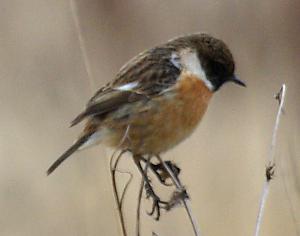


The Stonechat in Nottinghamshire is classed as an uncommon passage migrant and winter visitor. It breeds occasionally. In the Birds of Sherwood Forest{1869}, W J Sterland says that the Stonechat was common, particularly on the furze-clad parts of Sherwood Forest, numbers were somewhat lower in the winter. In the Notes on the Birds of Nottinghamshire{1907}, Joseph Whitaker said "Not at all a common bird in Notts., seen here and there, and I have come across them much oftener in the winter than at other times of the year". He also said that they bred occasionally, a similar situation to to-days.
Can be found in Nottinghamshire on uncultivated land with "spotting" perches. These perches are around 1½ metres high from which it can see its insect prey, and are something like a gorse bush or umbellifer plant.
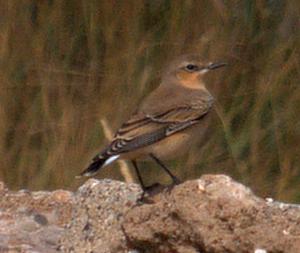
W. J. Sterland in the Birds of Sherwood Forest{1869} says the Wheatear summered in the rabbit warrens of Oxton and Boughton Brake. In the Notes on the Birds of Nottinghamshire{1907}, Joseph Whitaker said it bred in small numbers in the centre of the county as well as being a spring and autumn migrant.
These days it is a fairly common migrant with occasional breeding records. Usually found on passage on bare, ploughed or arable fields with the crop just emerging.
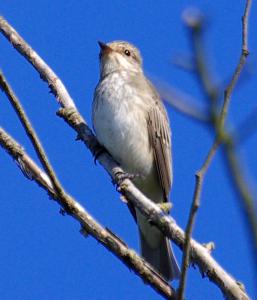
The Spotted Flycatcher used to be a fairly common summer visitor to Nottinghamshire, breeding in the city itself in places such as Wollaton Hall and Highfields, now it is much declined – 87% between 1967 & 2008. Reasons for the decline are not known. It could be the survival rate of first year birds as suggested in The decline of the Spotted Flycatcher in the UK {Freeman & Crick (2003)}. Other researchers have suggested a reduction in its insect prey over the years.
W. J. Sterland in the List of the Birds of Nottinghamshire{1879} stated This is a regular and abundant summer visitor, specially frequenting gardens, or their vicinity.
. J. Whitaker in his Notes on the Birds of Nottinghamshire {1907} says it was a common spring visitor
.
Generally its habitat is one of open areas with trees that have open raised perches. This means parks, cemeteries, large gardens and woodland glades.
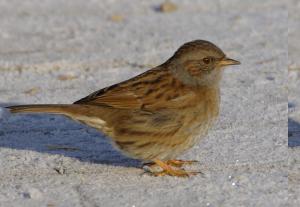
A very common resident in Nottinghamshire, found in most habitats, thickets, scrub, gardens and areas with overgrown hedges. It is not so common in woodland, preferring young coniferous plantations and areas of oak. W. J. Sterland in the Descriptive List of the Birds of Nottinghamshire {1879} says that it is abundant everywhere.
Dunnocks in Nottinghamshire do not move far throughout the year and little immigration takes place in the winter.
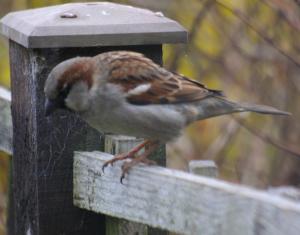
The House Sparrow is a fairly common resident in Nottinghamshire, but has declined since 1970. It is still found in suburban gardens, parks, villages and farmyards. Sterland did not consider it worth spending any space on discusing this bird in the Descriptive List of the Birds of Nottinghamshire {1879} because it was so common! It was described as an "Abundant resident" in The Birds of Nottinghamshire {1975, Dobbs}.
A study of House Sparrows in Leicester in 2002-2003 by Kate Vincent, showed that a key feature of the decline in the suburbs was starvation of the chicks soon after birth because of the lack of insects. Insects being important for the growth of the young.
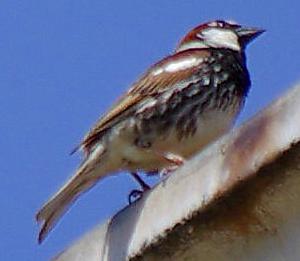
Whitaker gave a description of one obtained from a flock of House Sparrows at Wilford in the autumn of 1900. The record has not been accepted by the BOU
Several records have been accepted since and to my mind it is difficult to see why the Nottinghamshire one hasn't.
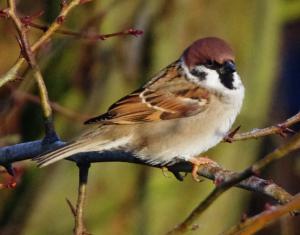
A fairly common resident of Nottinghamshire which has declined in the last thirty years. It is found in woodland in the breeding season (it needs holes for the nest) and the fields and hedgerows for the rest of the year.
Sterland in the Descriptive List of the Birds of Nottinghamshire {1879} considered it a common bird within its habitat. There was an expansion period from the 1950s until the mid 1970s (The Atlas of breeding birds in Britain and Ireland –1976 {Sharrock}). Dobbs in the The Birds of Nottinghamshire {1975} called it a "common resident". In the late 1970s and up to the 1990s the population crashed. Since 1995 a small increase has occurred in the East Midlands.
Any criticisms, corrections or comments to the author Derek Huskisson

This work is licensed under a Creative Commons Attribution-Noncommercial-Share Alike 2.0 UK: England & Wales License.